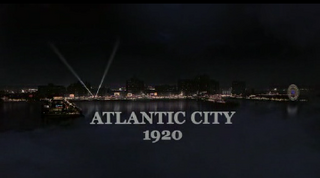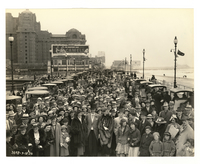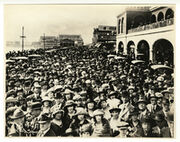
Aerial photo of Atlantic City as it appears in the pilot episode, Boardwalk Empire
Atlantic City is a city on Absecon Island on the coast of the Atlantic Ocean in Atlantic County, New Jersey. It is the central location of the Boardwalk Empire book and the HBO series Boardwalk Empire, and is occasionally alluded to in the series as The Emerald City. The city is governed by a council of Aldermen led by a Mayor, but the true power lies with Atlantic County Treasurer Nucky Thompson who presides over a political and criminal organization. The city had a population of 50,707 people in 1920. According to the Boardwalk Empire book, this would rise to approximately 300,000 people at the peak of tourist season.
History[]
The original inhabitants were the Lenni-Lenape Indians. They would travel for 5 miles over marshland on the Old Indian Trail (where Florida Ave. is today) from the Mainland to spend their summer months hunting and fishing on the island.
The first recorded owner of Absecon Island from the late 1670s was an Englishman by the name of Thomas Budd. He was given the island against a claim he had with the holders of the royal grant. His beach front land was valued at a mere $0.04 an acre. That same property today would be worth millions of dollars per acre. For the next one hundred years, the island would be visited by hunters and white settlers.

The first white man to build a permanent structure on the island was Jeremiah Leeds in 1785 (at what is now Arctic and Arkansas Ave). He and his family grew corn and rye and raised cattle on the Leeds Plantation. After his death in 1838, Leeds' second wife got a license to operate a tavern called Aunt Millie's Boarding House. Atlantic City's first business was born.
In 1850 a prominent physician on the island, Dr. Jonathan Pitney, had the idea of turning the island into a health retreat. He recruited the services of a civil engineer named Richard Osborne to help him bring the railroad to the island. Osborne is credited with naming the city, while Dr. Pitney thought of the names and placement for the city streets (streets running parallel to the ocean would be named after the great ocean bodies of the world and streets which ran east to west would be named after the States).
On July 5, 18

54, the first train arrived from Camden after an arduous 2-1/2 hour journey. The invasion of tourists to the island began. It didn't take long for real estate developers to recognize the island's potential as a resort destination. Lavish hotels and fancy restaurants sprang up, many of them featured in the show, such as Babette's Supper Club. Within twenty years there were nearly 500,000 passengers a year arriving by rail. And all these people were tracking mounds and mounds of sand into the hotel and restaurant lobbies. Something had to be done about it.
Alexander Boardman, a conductor for the Atlantic City-Camden Railroad, proposed building a boardwalk. City Hall accepted the proposal in 1870 and using half the city's annual tax revenue, built an 8 foot wide wooden structure from the beach to the town. It was not only functional, it was totally unique and the tourists loved it. The boardwalk was so popular it reached a length of 7 miles long (before the 1944 hurricane) and it fueled the city's explosive growth, with the city's first road from the mainland finishing construction in 1870 and two additional rail lines being added in 1878. Atlantic City was formally opened on Wednesday, June 16, 1880.

Tourism reached its zenith in the 1920s, and many historians consider this period the city's golden age. Despite Prohibition, liquor flowed freely and gambling regularly took place in nightclubs and back rooms...
Businesses[]
- Ritz Carlton Hotel
- The Artemis Club
- Shelburne Hotel
- St. Louis Hotel
- Cafe Frolic
- Cafe Beaux-Arts
- Babette's Supper Club
- Heilig's Chop House
- Hiawatha Garage
- La Belle Femme
- Dittrich's Photography
- Baby Incubators
- Lolly's Casino
- Berns' Funeral Home
- W. B. Shuyler Funeral Parlor
Other Locations[]
- Boardwalk
- Post Office
- Police Station
- Children's Hospital
- Armory
